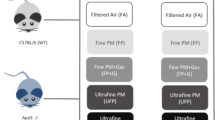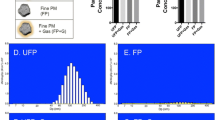Abstract
Fresh vehicular emissions potentially represent a ubiquitous environmental concern for cardiovascular health. We compared electrocardiographic effects of fresh gasoline engine emissions with resuspended paved road dust in a mouse model of coronary insufficiency. Apolipoprotein E (ApoE)−/− mice on a high fat diet were exposed by whole-body inhalation to either gasoline emissions at 60 μg/m3 particulate matter (PM), an equivalent atmosphere with particles filtered out of the whole exhaust, or paved road dust at 0.5 and 3.5 mg/m3 for 6 h/d for 3 d. Radiotelemetry recordings of electrocardiogram (ECG) were analyzed for changes in T-wave morphology (QT interval, T-wave amplitude, and T-wave Area). Following exposures, lung lavage and blood samples were obtained to assay for markers of pulmonary and systemic inflammation. No exposure induced significant changes in heart rate and only the high concentration of road dust induced signs of pulmonary inflammation. T-wave area exhibited significant deviation from baseline values during exposure to gasoline exhaust particulates, but not to either concentration of road dust or gasoline emissions sans particulates. Gasoline-exposed mice demonstrated elevated plasma endothelin-1, but did not cause systemic inflammation. These data support the hypothesis that freshly-generated engine emissions, as opposed to resuspended paved road dust, may drive cardiac effects that have been observed at road-sides in the environment. The absence of ECG effects for both very high concentrations of road dust PM and equivalent concentrations of the vapor/gas phase of gasoline engine exhaust further indicate the specific risk conferred by fresh vehicular PM.
Similar content being viewed by others
References
Peters, A., von Klot, S., Heier, M., et al. (2004). Exposure to traffic and the onset of myocardial infarction. N. Engl. J. Med. 351:1721–1730.
Riediker, M., Devlin, R.B., Griggs, T.R., et al. (2004). Cardiovascular effects in patrol officers are associated with fine particulate matter from brake wear and engine emissions. Part. Fibre Toxicol. 1:1–10.
Riediker, M., Cascio, W.E., Griggs, T.R., et al. (2004). Particulate matter exposure in cars is associated with cardiovascular effects in healthy young men. Am. J. Respir. Crit. Care Med. 169:934–940.
Henneberger, A., Zareba, W., Ibald-Mulli, A., et al. (2005). Repolarization changes induced by air pollution in ischemic heart disease patients. Environ. Health Perspect. 113:440–446.
Gold, D.R., Litonjua, A.A., Zanobetti, A., et al. (2005). Air pollution and ST-segment depression in elderly subjects. Environ. Health Perspect. 113:883–887.
Pekkanen, J., Peters, A., Hoek, G., et al. (2002). Particulate air pollution and risk of ST-segment depression during repeated submaximal exercise tests among subjects with coronary heart disease: the Exposure and Risk Assessment for Fine and Ultrafine Particles in Ambient Air (ULTRA) study. Circulation 106:933–938.
Brook, R.D., Brook, J.R., Urch, B., Vincent, R., Rajagopalan, S., and Silverman, F. (2002). Inhalation of fine particulate air pollution and ozone causes acute arterial vasoconstriction in healthy adults. Circulation 105:1534–1536.
Campen, M. J., Babu, N. S., Helms, G. A., et al. (2005). Nonparticulate components of diesel exhaust promote constriction in coronary arteries from ApoE−/− mice. Toxicol. Sci. 88:95–102.
Nurkiewicz, T. R., Porter, D. W., Barger, M., Castranova, V., and Boegehold, M. A. (2004) Particulate matter exposure imparis systemic microvascular endothelium-dependent dilation. Environ. Health Perspect. 112:1299–1306.
Caligiuri, G., Levy, B., Pernow, J., Thoren, P., and Hansson, G. K. (1999). Myocardial infarction mediated by endothelin receptor signaling in hypercholesterolemic mice. Proc. Natl. Acad. Sci. USA 96:6920–6924.
Gussak, I., Chaitman, B. R., Kopecky, S. L., and Nerbonne, J. M. (2000). Rapid ventricular repolarization in rodents: electrocardiographic manifestations, molecular mechanisms, and clinical insights. J. Electrocardiol. 33: 159–170.
Hemdahl, A. L., Falk, E., Thoren, P., and Hansson, G. K. (2004). Thrombin inhibitor reduces myocardial infarction in apoE-/- x LDLR-/- mice. Am. J. Physiol. Heart Circ. Physiol. 287:872–877.
Richer, C., Domergue, V., Gervais, M., Bruneval, P., and Giudicelli, J. F. (2000). Fluospheres for cardiovascular phenotyping genetically modified mice. J. Cardiovasc. Pharmacol. 36:396–404.
Godecke A., Ziegler, M., Ding, Z., and Schrader, J. (2002). Endothelial dysfunction of coronary resistance vessels in ApoE-/- mice involves NO but not prostacyclin-dependent mechanisms. Cardiovasc. Res. 53:253–262.
Wellenius, G.A., Coull, B.A., Godleski, J. J., et al. (2003). Inhalation of concentrated ambient air particles exacerbates myocardial ischemia in conscious dogs. Environ. Health Perspect. 111, 402–408.
McDonald, J. D., Barr, E. B., White, R. K., et al. (2004). Generation and characterization of four dilutions of diesel engine exhaust for a subchronic inhalation study. Environ. Sci. Technol. 38:2513–2522.
McDonald, J. D., Barr, E. B., and White, R. K. (2004). Design, characterization, and evaluation of a small-scale diesel exhaust exposure system. Aerosol. Sci. Technol. 38: 62–78.
Abu-Allaban, M., Gillies, J. A., Gertler, A. W., Clayton, R., and Proffitt, D. (2003). Tailpipe, resuspendend road dust, and brake-wear emission factors from on-road vehicles. Atmosphere. Environ. 37:5283–5293.
Cadle, S. H., Mulawa, P., Groblicki, P., et al. (2001). In-use light-duty gasoline vehicle particulate matter emissions on three driving cycles. Environ. Sci. Technol. 35:26–32.
Kodavanti, U. P., Schladweiler, M. C., Ledbetter, A. D., et al. (2000). The spontaneously hypertensive rat as a model of human cardiovascular disease: evidence of exacerbated cardiopulmonary injury and oxidative stress from inhaled emission particulate matter. Toxicol. Appl. Pharmacol. 164: 250–263.
Kang, Y. J., Li, Y., Zhou, Z., et al. (2002). Elevation of erum endothelins and cardiotoxicity induced by particulate matter (PM2.5) in rats with acute myocardial infarction. Cardiovasc. Toxicol. 2:253–261.
Thomson, E., Goegan, P., Kumarathasan, P., and Vincent, R. (2004). Air pollutant sincrease gene expression of the vasconstrictor endothelin-1 in the lungs. Biochim. Biophys. Acta 1689:75–82.
Campen, M. J., Nolan, J. P., Schladweiler M. C., et al. (2001). Cardiovascular and thermoregulatory effects of inhaled PM-associated transition metals: a potential interaction between nickel and vanadium sulfate. Toxicol Sci. 64:243–252.
Peters, A., Frohlich, M., Doring, A., et al. (2001). Particulate air pollution is associated with an acute phase response in men: results from the MONICA-Augsburg Study. Eur. Heart J. 22:1198–1204.
Schwartz, J. (2001) Air pollution and blood markers of cardiovascular risk. Environ. Health Perspect. 109(Suppl 3): 405–409.
Author information
Authors and Affiliations
Corresponding author
Rights and permissions
About this article
Cite this article
Campen, M.J., McDonald, J.D., Reed, M.D. et al. Fresh gasoline emissions, not paved road dust, alter cardiac repolarization in ApoE−/− mice. Cardiovasc Toxicol 6, 199–209 (2006). https://doi.org/10.1385/CT:6:3:199
Received:
Accepted:
Issue Date:
DOI: https://doi.org/10.1385/CT:6:3:199




